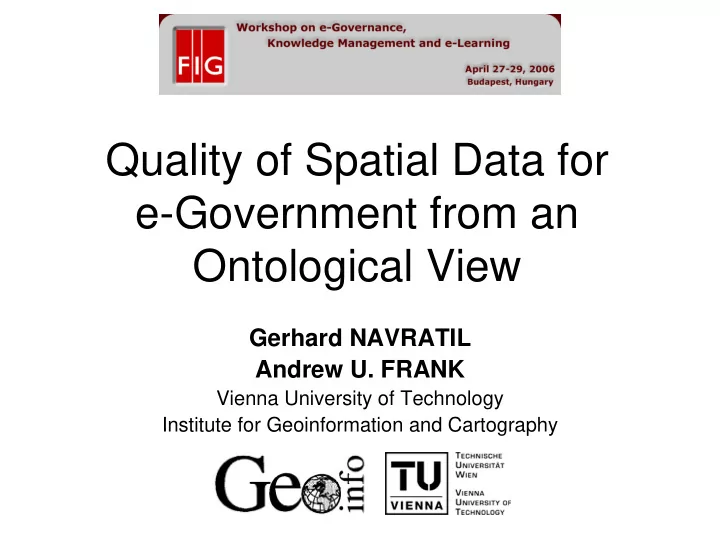

Quality of Spatial Data for e-Government from an Ontological View Gerhard NAVRATIL Andrew U. FRANK Vienna University of Technology Institute for Geoinformation and Cartography
Outline • Introduction • 5-tier Ontology • Measures of Quality • Decision Processes • Consequences for e-Government • Conclusions Navratil, Frank
Introduction • E-Government is one of the priorities of the European Union • Advantages: User friendly – „24/7“ access – Reduction of travel time – Reduction of interaction time • Requirement: Predictability Navratil, Frank
Example • Digital access to land register : Simplifies process of getting data • Digital application for registration : Simplifies registration process • Only possible if digital archive is complete! • Otherwise : Search necessary or outcome unpredictable Navratil, Frank
Problem • Connection between data quality and predictability • Approach: Tiered ontology Navratil, Frank
Ontology • Philosophy: Science of being (Aristotle) � only one Ontology • Computer Science: Explicit specification of a conceptualization (Gruber 1993) – Many different ontologies – Top-level ontologies provide a framework for these ontologies – 5-tier ontology is such a top-level ontology Navratil, Frank
5-tier Ontology Tier 0: Physical reality – assumes a single physical environment Tier 1: Point observations of tier 0 Tier 2: World of objects – set of points with unique properties Tier 3: Socially constructed reality (Searle 1995) – social objects Tier 4: Subjective reality of cognitive agents Navratil, Frank
Navratil, Frank
Measures of Quality • Quality: Superiority of a manufactured good/high degree of craftsmanship • Measures for quality of data necessary due to imperfect observation and classification processes • Quality of data on social reality – Observation: Data quality – Classification: Uncertainty Navratil, Frank
Data Quality • Observations contain errors • Described by statistical methods • List of different aspects (Guptill & Morrison 1995, Wang & Strong 1996, Veregin 1999) – Lineage – Accuracy – Completeness – Logical consistency – Semantic accuracy – Temporal accuracy Navratil, Frank
Uncertainty • Object classification is based on concepts • Concepts with vague boundaries lead to problems in the classification process • Main aspects (Fisher 1999, 2003) – Error – Vagueness – Ambiguity – Discord Navratil, Frank
Decision Processes • Data is collected to make decisions • Decisions may influence tier 2 or 3 • E.g. stabilizing the Leaning Tower of Pisa, subdivision of a land parcel • Tier 2: Technical system • Tier 3: Social/legal system Navratil, Frank
Decisions in technical systems • Statistical methods to deal with random deviations of observations • Statistical testing, adjustment computation • Decision based on specified confidence level • Can include old observations as well as new observations • Can optimize complex systems • Problem: Difficult to handle for humans Navratil, Frank
Decisions in legal systems • Based on subsumption – transforms the real situation to a social construct e.g. murder ist the unlawful killing of a human being with malice and forethought • Series of simple decision • Result will not be optimal in a technical meaning • Problem 1: Room for decisions • Problem 2: Combinations of technical and legal decisions (Is 3.96m less than 4.00m?) Navratil, Frank
Consequences for e-Government • Goal of e-Government: Simplification of administrative processes • Examples – tax declaration – application for inscription in land register – publication of laws • Common characteristics: Socially constructed objects only Navratil, Frank
Example Land Register • Contains owners, encumbrances, restrictions • Registration against owner/beneficiary only • Incomplete/wrong data on owners/ beneficiaries makes result unpredictable • Frequent problems with predictability may destroy trust � e-Government processes may not be used Navratil, Frank
Conclusions • Prime concern for e-Government is predictability • Key elements – Clear legal concepts – Data accessible for customer and used in process must be the same • Thus 2 steps to implement e-Government – Determine well established, straightforward administrative processes – Setup electronic processes for these administrative processes Navratil, Frank
Thank you! • Questions? • Comments? Gerhard Navratil, Andrew U. Frank {navratil,frank}@geoinfo.tuwien.ac.at Vienna University of Technology Institute for Geoinformation and Cartography Navratil, Frank
Recommend
More recommend